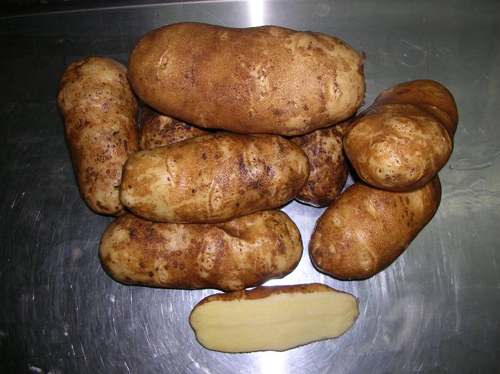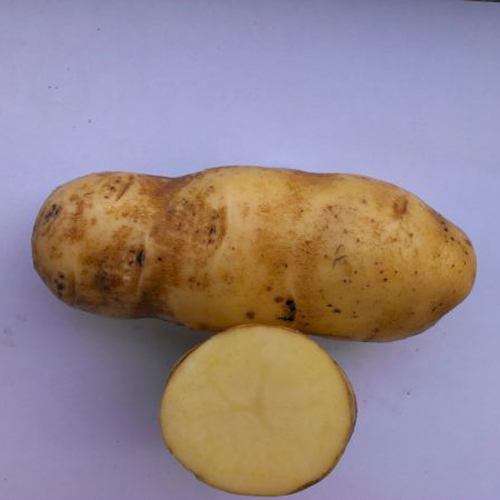Potato variety Innovator
The innovator is a Dutch mid-early potato variety (Solanum tuberosum) for table use. Bred by HZPC Holland B. V. specialists in the late 90s. In 2005 it was added to the state register of breeding achievements of the Russian Federation. Approved for cultivation in three regions of the country: Central, Volgo-Vyatka and Central black earth. Differs in stable productivity. Suitable for long-term storage and long-distance transportation. Resistant to mechanical damage, suitable for machine cleaning.
From the moment of emergence of full shoots to harvest, 75-85 days pass.

The plant is tall or medium, of an intermediate type, with a moderate amount of green mass. Stems are erect or semi-erect. Leaves are large, open type, light green in color, slightly wavy at the edges. The corollas of the potatoes are large, white in color. Abundant flowering, few berries are formed. The variety is distinguished by the intensity of foliage growth.
In one nest, 6-11 rather large homogeneous tubers with an average weight of 83-147 grams each are formed, sometimes even larger specimens are formed. Tubers are oval-elongated, with a strong yellow skin, rough to the touch. The pulp is light yellow in color. The eyes are small, superficial.
The marketable yield of the Innovator, according to the results of state tests, was recorded in the range of 155-329 c / ha, 23-108 c / ha higher than the indicators Lugovskoy and Petersburg. Such a large difference between the extreme values is due to the differences in climatic conditions and soils of the regions. The maximum number of tubers was harvested in the Kirov region - 344 c / ha, 36 c / ha higher than the results of St. Petersburg. Marketability at a high level - 82−96%. Keeping quality is 95%.

The potato tastes good and satisfactory. The tubers are poorly boiled, they are best suited for making soups, salads, vegetable mixtures, as well as for stuffing, cooking and frying. They are not particularly suitable for mashed potatoes. During heat treatment, the pulp changes color slightly. The starch content in it is 12-15%.
The innovator is relatively picky about soil fertility and climatic conditions of growth. The best yield can be achieved on loose soils, rich in nutrient and mineral composition. The climate is preferable to be mild. In agricultural technology, the variety is unpretentious, requires only the most standard techniques. However, there are several nuances of growing.
- Experts recommend planting tubers at great depths. On light soils, you can embed it to a depth of 15 cm.On heavy soils, do not be too zealous - about 8 cm will be enough.
- It is advisable to make the planting ridges higher.
- You should not rush to harvest. You need to wait until a rather thick skin is formed on the tubers in order to avoid mechanical damage to the potatoes during digging.
- It is extremely important to carry out timely preventive measures to combat diseases and pests. Also, one should not neglect the observance of crop rotation. The best predecessors will be cabbage, zucchini, legumes, green manure, onions, garlic, beets.
- Do not forget about the basic elements of care, such as loosening the soil, weeding weeds, hilling, watering and feeding. By the way, our hero is drought-resistant, but soil moisture is still required, especially in regions with hot summers.
The innovator is resistant to pallid nematode and cancer pathogen. Vulnerable to aureus cyst nematode. According to the All-Russian Research Institute of Phytopathology, it is moderately susceptible to late blight in tubers and tops. Prone to defeat by rhizoctonia.
The variety has received many positive reviews.It is especially appreciated for its high stable yield, unpretentious care, excellent keeping quality, good presentation of tubers and their taste, as well as resistance to mechanical damage and drought. Gardeners note the independence of the yield from the weather conditions of the season. Another plus is that these potatoes can be successfully grown from seeds.
Among the disadvantages, susceptibility to some diseases is noted. But this problem can be solved by timely implementation of preventive measures. Otherwise, the Innovator showed himself very well on his personal plots and production areas of large agricultural complexes.
The cultivation of the variety in Russia is officially carried out by: FGBNU "VNII Potato Farm named after A. G. Lorkh" in the Moscow Region, Peasant (farm) farm "Kapitalinia" in the Tula Region, LLC "Agrofirma Krimm" in the Tyumen Region, LLC "Alchak" in Tatarstan, OOO Aksentis in the Nizhny Novgorod region, OOO SSK Uralsky potato in the Sverdlovsk region, OOO ETK Meristemnye kultury in the Stavropol Territory.








